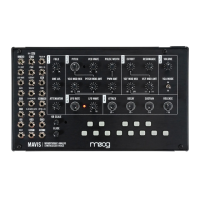25 | The Voltage Controlled Filter (VCF)
RESONANCE
Also known as Emphasis, or Q, RESONANCE takes a portion of the Filter
output and channels it back to the input of the Filter. This creates a
resonant peak, or boost, that occurs at the Cuto frequency. Rotating the
RESONANCE knob clockwise will increase this resonant peak; rotating the
knob counterclockwise will decrease the amount of this resonant peak.
At maximum Resonance settings, the VCF can become self-oscillating. As
modulation is applied to the Cuto frequency, the relationship between
Cuto and Resonance can be heard with more clarity.
FILTER MODULATION PARAMETERS
As with Oscillator Modulation, Mavis contains two modulation sources that can be applied to vary the
Cuto frequency of the Filter. The first is the LFO (Low Frequency Oscillator). This provides a repeating,
cyclic change based on the current settings of the LFO RATE and LFO WAVE parameters. The second is
the EG (Envelope Generator). This creates a one-shot, continuously changing control signal based on the
current settings of the ATTACK, DECAY, SUSTAIN, and RELEASE knobs. In this case, EG modulation can
be used to add articulation to each note as it is played, or to create other dramatic modulation sweeps.
This EG control signal begins anew each time a key is pressed or an external Gate is received.
VCF MOD MIX (Voltage Controlled Filter Modulation Mix)
Mavis allows both modulation sources to be applied to the value of the
Cuto frequency parameter simultaneously. The VCF MOD MIX knob sets the
balance between the two modulation sources (LFO and EG). Rotating this
knob fully counterclockwise will select only the EG as the modulation source.
Rotating this knob fully clockwise will select only the LFO as the modulation
source. In between those two extremes, the VCF MOD MIX knob acts as a
balance control, or crossfader, between these two modulation sources.
VCF MOD AMT (Voltage Controlled Filter Modulation Amount)
This knob determines the amount of modulation being applied to the Cuto
frequency. Unlike any of the other Mavis knobs, this control is bi-polar. In
the center position, no modulation is being applied; the modulation amount
is zero. Turning the knob clockwise from the zero point will add more and
more modulation to the Cuto frequency parameter. Turning this knob
counterclockwise from the zero point will still add more and more modulation
to the value of Cuto frequency parameter, however, this modulation will
have an inverse value. For example, instead of the EG ATTACK parameter
raising the Cuto frequency over time, as with a positive VCF MOD AMT
value, the EG ATTACK parameter would instead lower the Cuto frequency
over time when a negative VCF MOD AMT value is chosen.

